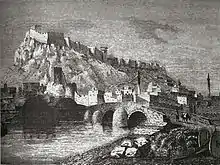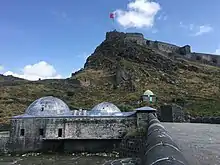| Siege of Kars | |||||||
|---|---|---|---|---|---|---|---|
| Part of the Ottoman–Persian War (1743–46) and the Campaigns of Nader Shah | |||||||
 | |||||||
| |||||||
| Commanders and leaders | |||||||
|
|
| ||||||
The siege of Kars, in 1744, occurred during the Ottoman-Persian War of 1743-1746. Nader Shah, ruler of Persia, laid siege to the city on 29 July 1744.
Prelude
After suffering a major defeat at the siege of Mosul in 1743, the Iranian army under the command of Nader Shah agreed to an armistice negotiated by the governor of Mosul, Abdülcelilzade, which included a prisoner exchange with Hüseyin Pasha. Later, while serving as governor of Baghdad, he returned control of Kirkuk and Erbil to the Ottoman Empire, which he had previously occupied with the consent of Ahmed Pasha. Finally, the siege of Basra was lifted.[1]
During the winter of 1743-1744, Nader Shah participated in a number of rebellions, some of which were supported by the Ottomans. In December 1743, Nader successfully suppressed the Lezgin attacks from Dagestan, although he faced struggles within the kingdom, such as the Shiraz uprising led by the Persian Beylerbeyi Taki Khan. Nader also faced Qajar uprisings in Esterabad. The Ottoman Empire completed its military preparations on the front against Iran with the help of Baghdad Governor Ahmed Pasha's diversionary tactics against Nader Shah, who managed to suppress them until the Nowruz festival. In addition, Kars Serasker Nişancı Ahmed Pasha, and East Anatolian Seraskier Aleppo Governor Kazıkchı Hüseyin Paşa were appointed, as well as the Seraskier Governor of Baghdad Ahmed Pasha for Iraq.[2]
The commander of the Kars garrison, Nişancı Ahmed Pasha, received orders to assist Safi Mirza, the Iranian prince who was vying for the throne. Nader Shah's primary objective was to neutralize this threat by capturing and blinding Safi Mirza before sending him to Kars.[3] Nader Shah then launched an attack on Kars.
Siege


The Iranian army under the command of Nader Shah arrived in Kars on 29 July 1744 after crossing Arpaçay via Tabriz-Nakhchivan. Once there, Nader established his headquarters on a hill to the south of the city and ordered metrics to be dug around the fortress of Kars. He then sent a letter to the commander of the garrison, Nişancı Ahmed Pasha, offering to surrender, stating that artillery was not necessary to capture the castle and that it would be enough to cut off its water supply.[4]
Ahmed Pasha did not respond to the offer. The Persian army took defensive measures before reaching the castle, including enlarging the lake with water from the Kars River, digging a wide and deep ditch around the perimeter, constructing two-meter long trenches with cannons, and fortifying the trenches with additional cannons to create a line of defense.[5]
Despite the preparations, the Ottoman garrison's chain of command showed weakness and followed the Serasker's orders. As a result, a group of disobedient Ottoman soldiers wanted to leave the castle and launch an attack on the Iranian army. In order to organize the situation, Ahmed sent Veli Pasha as a commander. However, the Ottoman troops failed in their mission and eventually retreated to the castle.
Nader Shah wanted to strengthen the siege and decided to connect Kars and Erzurum. He moved his headquarters to Kümbet, a village on the Kars-Erzurum road, to block any Ottoman movement and began his attacks. Despite ten military offensives within a month, the Iranian army was unable to maintain its position due to heavy losses. The Ottomans were aware of the Persians' shortcomings in siege warfare and took advantage of their weaknesses.[6] The most serious of these attacks took place on 25 August. Despite their best efforts, the Iranians were unable to break through the castle's defenses.[7] 1,700 Iranian soldiers, two Pashas, and 80 Ottoman soldiers died.
Nader Shah used a familiar tactic to cut off the castle's water supply when his attacks failed to bring it down. However, his attempt to divert the Kars Stream on 2 September by placing camel-loads of cotton from Revan between the tree stakes failed when the autumn rains began to fall and the Kars Stream returned to its old bed.
Nader Shah, who did not get any results from this tactic, invited the Ottoman ambassador Defterdar Kesriyeli Ahmet Efendi to his headquarters and made new peace offers, but these were also not accepted.
As a result, Nader Shah intensified the siege on 13 September 1744. The Ottoman forces in the castle were deployed as follows: Tırhala Beylerbeyi Murteza Pasha at the Behrampaşa Gate in Ankara; Nevşehir under the command of the Janissaries in Gözcütepe; and Trabzon Governor Selim Pasha at the head of the soldiers of the Niğde and Kütahya Banners. In the bastion in front of the Mosque, Erzurum Governor Veli Pasha and Mustafa Pasha were stationed on the right wing, while soldiers and militiamen from Izmit were stationed in the western bastion under the command of Levent. Nişancı Ahmed Pasha was also stationed there. The camp sergeant was in charge of the artillery troops positioned in front of the hill inside the castle. Soldiers from the Alâiye, Karahisar and Icel banners held the slopes of the hill. Bayrakdar Ahmed Pasha, who was responsible for the protection of these soldiers, was in charge of the Timurpasa Bastion together with Karaman Beylerbeyi Abdullah Pasha.[8]
Nader Shah, from his headquarters around Kümbet, entered the castle and besieged it with trenches and towers. On 18 September, he fired a salvo of field artillery at the Timurpasa bastion. A general offensive was planned for the next day. However, the Ottoman garrison retreated before dawn and soon surrounded the Iranian army. They prepared for an attack with the Huruç Operation, which they carried out. The Iranian army fled on 19 September, leaving behind nine field guns.[9]
For three weeks after the initial attack, the Iranian army occupied a valley leading to the castle and relentlessly bombarded it with 16 large cannons. Despite their efforts, the fortress remained intact and casualties mounted due to the harsh cold weather. Finally, on 9 October 1744, after an unsuccessful siege of 73 days, Nader Shah gave the order to withdraw.[10]
References
Citations
- ↑ "History of Nadir Shah", V. Minorsky, Trans. Rashid Yasemi, Tehran 313, p.97.
- ↑ "History", Süleyman İzzi Efendi, Istanbul 1119, vrk.6/a.
- ↑ "Alem-ara-yi Nadiri", Muhammed Kazım (Vizier-i Merv), I-III, arrow. M. Emin Riyahi, Tehran, 1374, p.1042
- ↑ "Makale-i Vaka-i Muhasara-i Kars", Sırrı Efendi, Es'ad Efendi Library (Süleymaniye), no. 2417, vrk.9/b.
- ↑ I. H. Danişmend, ibid, IV, p.31.
- ↑ "The Siege of Mosul and Ottoman-Persian Relations", Robert W. Olson, Routledge (2017)
- ↑ "The Great Ottoman History", Joseph von Hammer, c.15, p.62
- ↑ "The Great Ottoman History", Joseph von Hammer, vol.15, pp.62-63
- ↑ "The Great Ottoman History", Joseph von Hammer, vol.15, p.63
- ↑ History of Kars", F. Kırzioğlu, Istanbul (1953), p.544